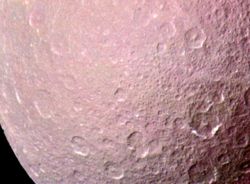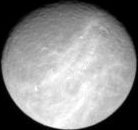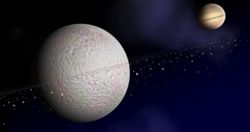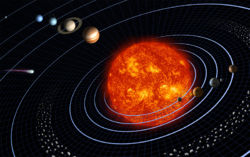Rhea (Moon)
 From Conservapedia
From Conservapedia | Rhea | |
|---|---|
 True-color image of Rhea taken by Voyager 1 | |
| Date of discovery | December 23, 1672[1] |
| Name of discoverer | Giovanni Domenico Cassini[1] |
| Name origin | Titaness and mother of Zeus by Kronos |
| Orbital characteristics | |
| Primary | Saturn |
| Order from primary | 19 |
| Perikrone | 526,513 km[2] |
| Apokrone | 527,567 km[2] |
| Semi-major axis | 527,040 km[3] |
| Orbital eccentricity | 0.0010[3] |
| Sidereal month | 4.517500 da[3] |
| Inclination | 0.35°[3] to Saturn's equator |
| Rotational characteristics | |
| Sidereal day | 4.517500 da[3] |
| Rotational speed | 12.3 m/s[2] |
| Physical characteristics | |
| Mass | 2.309 * 1021 kg[3] |
| Density | 1,230 kg/m³[3] |
| Mean radius | 764.5 km[3] |
| Surface gravity | 0.2634 m/s²[2] |
| Escape speed | 0.6346 km/s[2] |
| Surface area | 7,344,544 km²[2] |
| Minimum temperature | 63 K[4] |
| Mean temperature | 76 K[5] |
| Maximum temperature | 99 K[4] |
| Composition | Water ice and rock mixture[4] |
| Color | Pink-gray |
| Albedo | 0.7[3] |
Contents
- 1 Discovery and naming
- 2 Orbital and rotational characteristics
- 3 Physical characteristics
- 3.1 Surface
- 3.2 Interior
- 4 Ring system
- 5 Observation and Exploration
- 6 References
Discovery and naming[edit]
Giovanni Domenico Cassini discovered Rhea, along with the moons Tethys, Dione, and Iapetus, in the latter half of the seventeenth century, during the reign of "Sun-King" Louis XIV of France.[1] Cassini named these moons the "Sidera Lodoicea" in honor of the king. Later generations (especially after the French Revolution) would not retain such regal flattery.[6]
Sir John Herschel, son of the astronomer William Herschel, suggested the current names of the seven largest satellites of Saturn, including Rhea. Titan received a generic name, and the other six received names of the Titans of mythology. Rhea was the wife of Kronos or Cronus and mother of Zeus, the eventual king of the gods.[7]
Orbital and rotational characteristics[edit]
Rhea is in a relatively circular orbit around Saturn, at a mean distance of 527,040 km. It makes one orbit around Saturn in 4.52 days. Rhea is in tidal lock with Saturn and hence its rotation is synchronous with its orbit.
Physical characteristics[edit]
Rhea is a low-density body consisting mainly of water ice.
Surface[edit]

The trailing hemisphere of Rhea has multiple wisp-like formations that might be mountain ranges.
Interior[edit]
The density of Rhea at first led astronomers to believe that Rhea had a rocky core consisting of one-third the total mass of the body, and a mantle of water ice.[8] But recent evidence suggests an undifferentiated interior. Specifically, the moment of inertia for Rhea is 0.3911 ± 0.0045 kg m², which suggests that Rhea's rock and ice are evenly mixed, with compression of the ice from Ice I to Ice II toward the core.[9]
Ring system[edit]

Observation and Exploration[edit]
The first spacecraft to explore Rhea was Voyager 1. The Cassini orbiter has made two close rendezvous with Rhea during its first four years of operation, on November 26, 2005, and August 30, 2007. Mission planners have fixed a date for another rendezvous with Rhea on March 2, 2010, during the two-year extended mission.
References[edit]
- ↑ 1.0 1.1 1.2 "Gazetteer of Planetary Nomenclature: Planetary Body Names and Discoverers." US Geological Survey, Jennifer Blue, ed. March 31, 2008. Accessed April 17, 2008.
- ↑ 2.0 2.1 2.2 2.3 2.4 2.5 Calculated
- ↑ 3.0 3.1 3.2 3.3 3.4 3.5 3.6 3.7 3.8 Williams, David R. "Saturnian Satellite Fact Sheet." National Space Science Data Center, NASA, November 23, 2007. Accessed June 4, 2008.
- ↑ 4.0 4.1 4.2 Harvey, Samantha. "Entry for Rhea." Solar System Exploration, NASA, October 6, 2003. Accessed June 4, 2008.
- ↑ "Entry for Rhea." Sea and Sky Tour of the Solar System. Accessed June 4, 2008.
- ↑ Boulay, J. C. "Saturne: les satellites." Astronomie-astronautique. Accessed June 5, 2008.
- ↑ Lassell, William. "Satellites of Saturn." Monthly Notices of the Royal Astronomical Society, 8(3):42-43, January 14, 1848. Accessed June 4, 2008.
- ↑ Anderson, J. D., Rappaport, N. J.; Giampieri, G.; et. al. "Gravity field and interior structure of Rhea" Physics of the Earth and Planetary Interiors, 2003; volume 136, 201-213
- ↑ Anderson, J. D., and Schubert, G. "Saturn's satellite Rhea is a homogeneous mix of rock and ice." Geophysical Research Letters 34(L02202), January 18, 2007. doi:10.1029/2006GL028100 Accessed June 5, 2008.
- ↑ Martinez, C., and Brown, D. "Saturn's Moon Rhea Also May Have Rings." Cassini mission pages, NASA, March 6, 2008. Accessed June 5, 2008.
- ↑ Jones, G. H., Roussos, E., Krupp, N., et al. "The Dust Halo of Saturn's Largest Icy Moon, Rhea." Science 319(5868):1380-1384, March 7, 2008. doi:10.1126/science.1151524 Accessed June 5, 2008.
- ↑ Lakdawalla, Emily. "A Ringed Moon of Saturn? Cassini Discovers Possible Rings at Rhea." The Planetary Society, March 6, 2008. Accessed June 5, 2008.
| |||||||||||||||||||||||||||||
↧ Download as ZWI file | Last modified: 03/04/2023 03:56:47 | 11 views
☰ Source: https://www.conservapedia.com/Rhea_(moon) | License: CC BY-SA 3.0
 ZWI signed:
ZWI signed:
 KSF
KSF